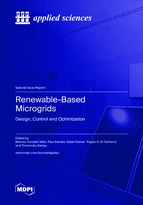Renewable-Based Microgrids: Design, Control and Optimization
A special issue of Applied Sciences (ISSN 2076-3417). This special issue belongs to the section "Energy Science and Technology".
Deadline for manuscript submissions: closed (15 December 2022) | Viewed by 25273
Special Issue Editors
Interests: energy/battery management; energy communities; electric vehicles; energy storage; energy systems modeling and optimization; renewable energy
Special Issues, Collections and Topics in MDPI journals
Interests: advancements in energy storage technologies; innovations in electrical protection systems; power quality enhancement strategies; power smoothing techniques in electrical networks; batteries
Special Issues, Collections and Topics in MDPI journals
Interests: power system analysis and optimization; smart grid; renewable energy systems
Special Issues, Collections and Topics in MDPI journals
Interests: power system modeling, computation, and control; renewable energy; microgrids
Special Issues, Collections and Topics in MDPI journals
Interests: high-efficiency energy conversion system; renewable energy in small islands; optimization of power system operation and control
Special Issues, Collections and Topics in MDPI journals
Special Issue Information
Dear Colleagues,
The electricity sector is evolving toward a decarbonized future. In this context, microgrids are emerging as an unvaluable framework for the integration of renewable generators, storage facilities and, also, for energy supply in remote areas. At present, there are already several types of renewable sources that take advantage of natural resources such as solar, wind, biomass, hydroelectric, etc., where each one contributes different and complementary properties. In some cases, especially in standalone grids, energy storage systems serve as support to increase the reliability of the network. However, microgrid operation, design, and control are still complex tasks because they involve integration of multiple energy vectors and renewable-based generators that are often affected by stochastic, intermittent, and unpredictable behavior of weather parameters. In this context, typical tools that have been used for years in conventional large power systems based on non-renewable sources have to be revisited. This Special Issue aims to cover the most recent advances in the optimization, design, and control of microgrid systems with high penetration of renewable sources and the involved technologies, thus collecting innovative and original works alongside literature reviews and comparative studies. Topics of interest include, but are not limited to, the following:
- Optimal design of renewable-based microgrids
- Developing and applying recent optimization techniques for renewable-based microgrids
- Hybrid power systems based on renewable energies
- Energy management in microgrids with renewable energy sources
- Energy management tools for renewable-based microgrids
- Modeling and control of microgrid
- Communication infrastructures for renewable-based microgrids
- Hybrid energy storage system for microgrids
- Multi-energy microgrids
- Weather and demand forecasting methods
- Microgrid security assessment
- Clean mobility integration in microgrids
- Power electronics for renewable-based microgrids
- Microgrid clusters and energy markets
Dr. Marcos Tostado-Véliz
Dr. Paul Arévalo
Prof. Dr. Salah Kamel
Prof. Dr. Ragab El Sehiemy
Prof. Dr. Tomonobu Senjyu
Guest Editors
Manuscript Submission Information
Manuscripts should be submitted online at www.mdpi.com by registering and logging in to this website. Once you are registered, click here to go to the submission form. Manuscripts can be submitted until the deadline. All submissions that pass pre-check are peer-reviewed. Accepted papers will be published continuously in the journal (as soon as accepted) and will be listed together on the special issue website. Research articles, review articles as well as short communications are invited. For planned papers, a title and short abstract (about 100 words) can be sent to the Editorial Office for announcement on this website.
Submitted manuscripts should not have been published previously, nor be under consideration for publication elsewhere (except conference proceedings papers). All manuscripts are thoroughly refereed through a single-blind peer-review process. A guide for authors and other relevant information for submission of manuscripts is available on the Instructions for Authors page. Applied Sciences is an international peer-reviewed open access semimonthly journal published by MDPI.
Please visit the Instructions for Authors page before submitting a manuscript. The Article Processing Charge (APC) for publication in this open access journal is 2400 CHF (Swiss Francs). Submitted papers should be well formatted and use good English. Authors may use MDPI's English editing service prior to publication or during author revisions.
Keywords
- renewable-based microgrids
- hybrid power systems
- optimization techniques
- renewable energy resources
- energy management strategies
- control of microgrids
- communication infrastructures of microgrids
- micro hybrid energy storage systems
- multi-energy microgrids
- weather and demand forecasting
- security analysis of microgrids
- clean mobility integration in microgrids
- home energy management tools
- power electronics for microgrids
- microgrid energy markets
- microgrid clusters










